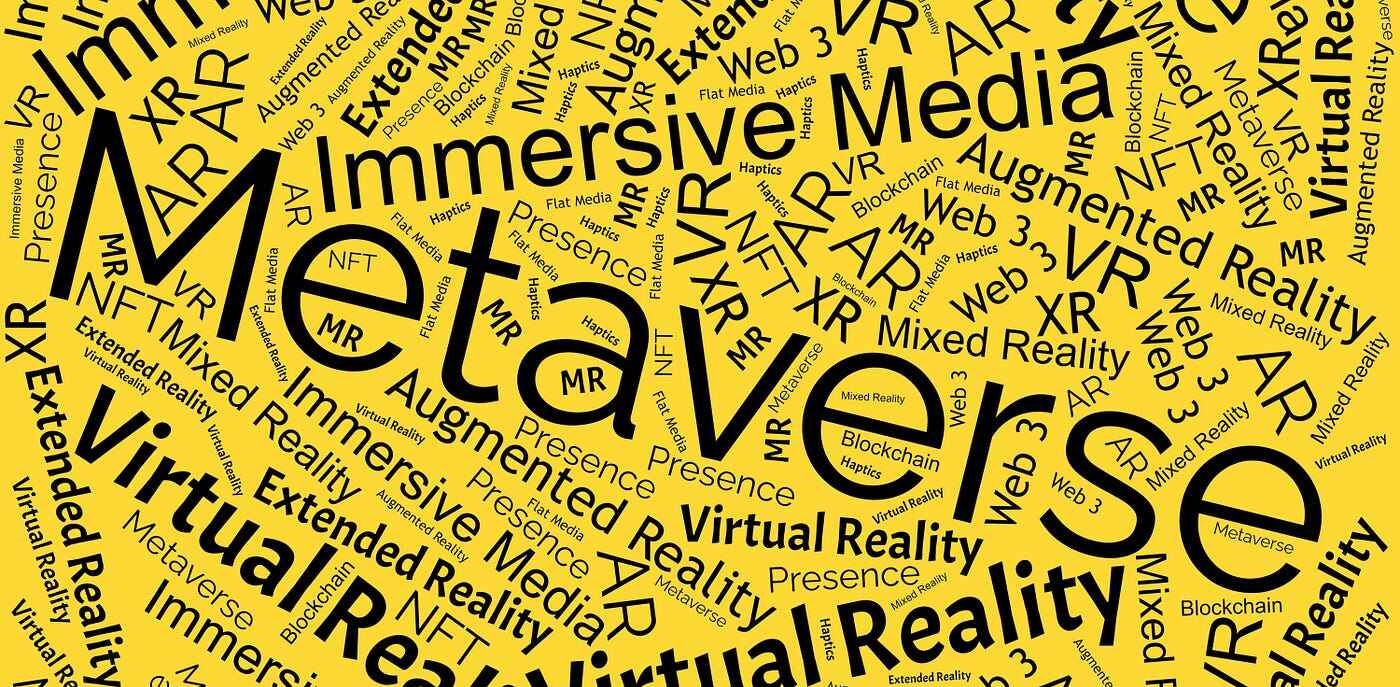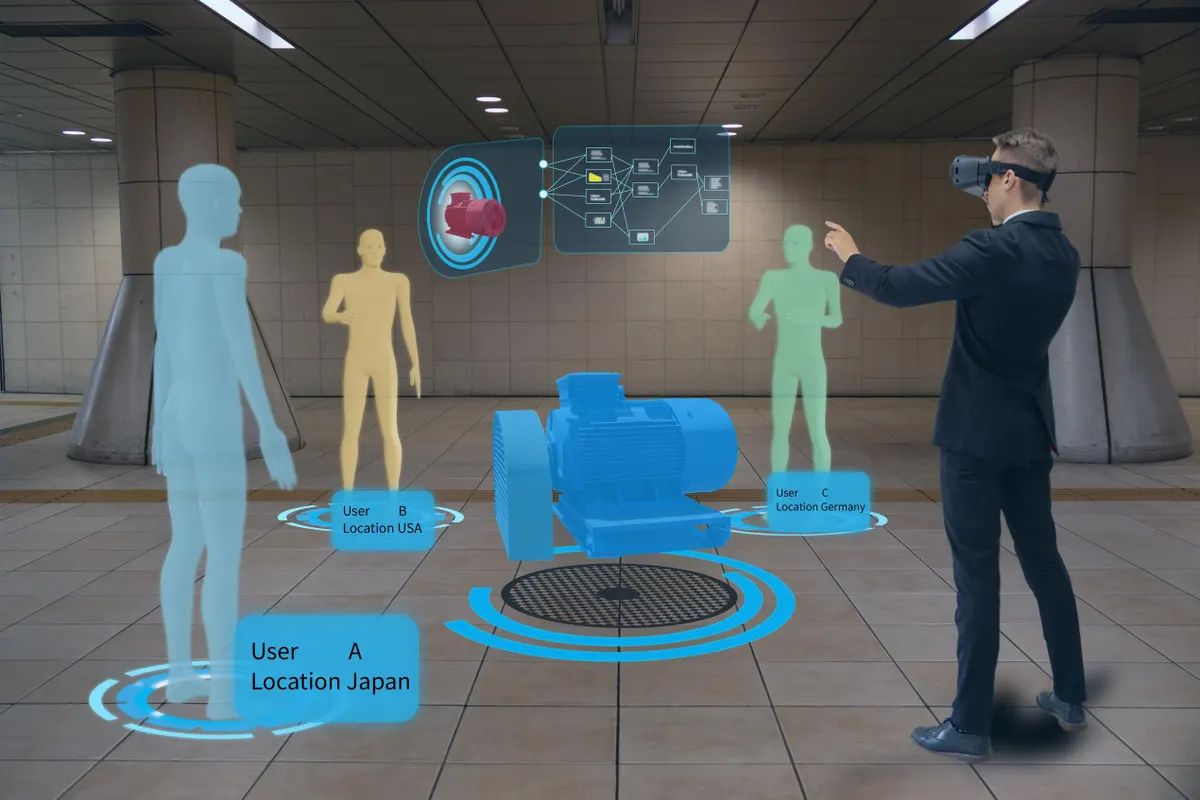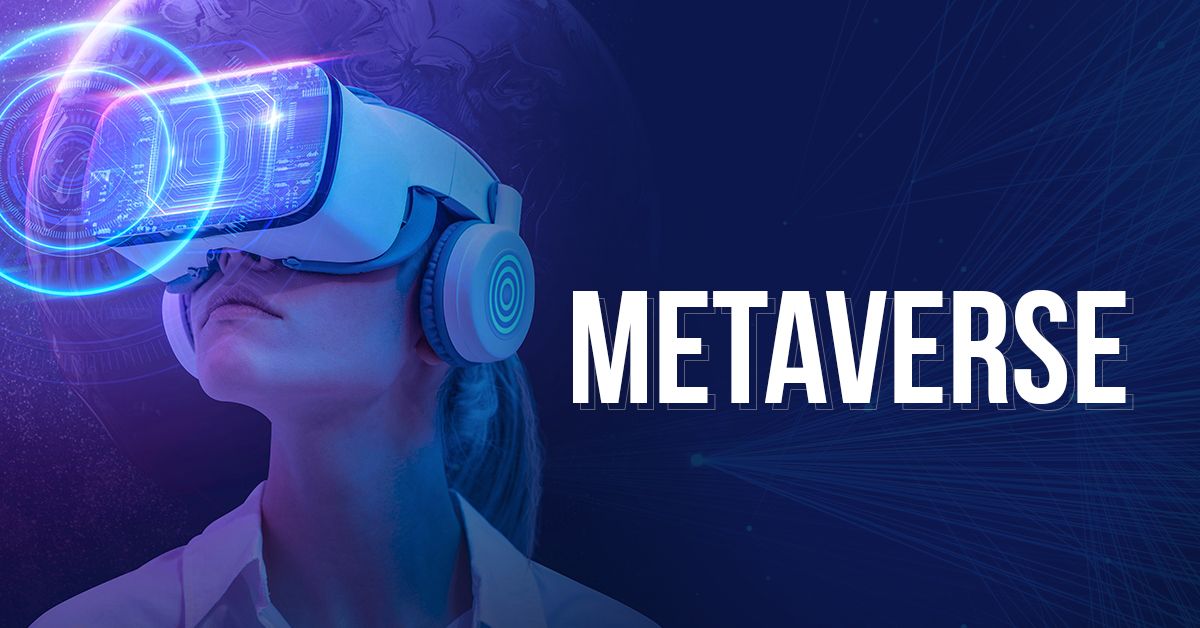Introduction
Welcome to the exciting world of the Metaverse. As technology continues to advance, the concept of the Metaverse has captured the imagination of many. The Metaverse refers to a virtual reality space where users can interact with a computer-generated environment and other users in real-time.
But have you ever wondered what language the Metaverse is written in? Just like any other software or application, the Metaverse relies on programming languages to bring it to life. These languages serve as the backbone of the virtual reality experience, enabling the creation and execution of the intricate systems that power the Metaverse.
In this article, we’ll explore the programming languages commonly used in the development of the Metaverse. We’ll dive into the unique features and use cases of each language, as well as the considerations and challenges associated with choosing the right language for Metaverse development.
Whether you’re an aspiring developer looking to enter the world of the Metaverse or simply curious about the technologies behind it, this article will provide you with a comprehensive understanding of the programming languages that make the Metaverse possible.
Background on the Metaverse
The concept of the Metaverse has its roots in science fiction, but in recent years, it has gained significant traction as technology has advanced. The term was coined by Neal Stephenson in his 1992 novel, “Snow Crash,” where he envisioned a virtual reality space where people could interact and engage with each other and digital environments.
In today’s context, the Metaverse is more than just a fictional concept. It represents an interconnected network of virtual worlds, augmented reality experiences, and online communities that transcend traditional boundaries. The goal is to create a seamless and immersive digital environment where users can work, play, and connect with others.
The Metaverse has the potential to revolutionize various industries, including gaming, education, entertainment, and even commerce. Imagine attending virtual concerts, exploring realistic digital landscapes, or collaborating with colleagues from around the world without leaving your home. The possibilities are endless.
However, building and maintaining such a complex system requires a solid foundation of programming languages. These languages allow developers to create the interactive and dynamic elements within the Metaverse that users can experience and engage with.
Now that we have a basic understanding of the Metaverse, let’s explore the specific programming languages that power this virtual reality realm.
The Role of Programming Languages in the Metaverse
Programming languages play a critical role in the development of the Metaverse. They provide the means to create, manipulate, and control the various elements that bring the virtual reality experience to life. These languages allow developers to build interactive environments, design intricate systems, and enable user interactions within the Metaverse.
One of the key functions of programming languages in the Metaverse is rendering. Rendering involves generating realistic and immersive visuals that make the virtual world come alive. Programming languages enable developers to code the algorithms and functions required for rendering complex 3D graphics, lighting effects, and realistic physics simulations.
In addition to rendering, programming languages are also responsible for handling user interactions within the Metaverse. Whether it’s the ability to move and interact with objects, communicate with other users, or perform actions within the virtual environment, programming languages facilitate the implementation of these functionalities. By utilizing event-driven programming paradigms, languages empower developers to create responsive and interactive experiences for Metaverse users.
Furthermore, programming languages are utilized for backend development in the Metaverse. This involves managing user accounts, storage of virtual assets, handling transactions, and ensuring security within the virtual reality space. Languages such as JavaScript, Python, and Java are commonly used for backend development, providing the necessary tools and frameworks to build robust and scalable systems.
Moreover, programming languages also play a role in the integration of various components within the Metaverse ecosystem. They enable communication between different systems, such as virtual reality headsets, user interfaces, and external APIs. Programming languages facilitate the seamless integration of these components, allowing for a cohesive and interconnected virtual reality experience.
In summary, programming languages are essential for the development of the Metaverse as they enable rendering, handle user interactions, facilitate backend development, and integrate various components. The choice of programming language depends on factors such as performance requirements, developer preferences, and compatibility with existing technologies. Now, let’s explore some of the commonly used programming languages in the Metaverse.
Common Programming Languages in the Metaverse
There are several programming languages commonly used in the development of the Metaverse. Each of these languages has its advantages and specific use cases within the virtual reality space. Let’s take a closer look at some of the commonly used programming languages in the Metaverse:
- C#: C# (pronounced C-sharp) is a popular programming language initially developed by Microsoft. It is commonly used in the Unity game engine, which is widely utilized for creating virtual reality experiences. C# is known for its object-oriented nature and ease of use, making it a preferred choice for VR game development in the Metaverse.
- JavaScript: JavaScript is a versatile programming language that plays a significant role in web development. In the context of the Metaverse, JavaScript is often used to create interactive elements and dynamic user interfaces. It can be utilized in conjunction with frameworks like A-Frame and Three.js to build virtual reality experiences that run in web browsers.
- Java: Java is a powerful and widely adopted programming language known for its robustness and platform independence. It is often used for developing backend systems and server-side applications within the Metaverse. Java provides developers with a vast ecosystem of libraries and frameworks that simplify the creation of complex virtual reality environments.
- C++: C++ is a high-performance programming language that offers direct hardware control and low-level memory management. It is commonly utilized in game engines like Unreal Engine, which powers many immersive virtual reality experiences. C++ allows for efficient and optimized code execution, making it suitable for demanding real-time rendering tasks in the Metaverse.
- Python: Python is a versatile and beginner-friendly programming language known for its simplicity and readability. While not as performant as languages like C++, Python finds its place in the Metaverse for tasks such as backend development, artificial intelligence, and scripting. Its extensive libraries and frameworks make it ideal for rapid prototyping and development.
- Rust: Rust is a relatively new systems programming language that focuses on safety, performance, and concurrency. It has gained popularity in the Metaverse for its ability to create secure and efficient code. Rust excels in areas such as low-level graphics programming, networked applications, and building robust virtual reality systems.
- Lua: Lua is a lightweight and embeddable scripting language known for its simplicity and flexibility. It is often used in the gaming industry, allowing developers to extend the functionality of game engines and customize gameplay mechanics within the Metaverse. Lua’s ease of integration and fast execution make it a popular choice for scripting virtual reality experiences.
- Go: Go, also known as Golang, is a modern programming language developed by Google. It is designed to be efficient, scalable, and concurrent, making it suitable for building distributed systems within the Metaverse. Go’s simplicity and built-in support for concurrent programming make it a valuable tool for creating high-performance virtual reality applications.
These are just a few examples of the programming languages commonly used in the Metaverse. The choice of language depends on factors such as performance requirements, development time, community support, and compatibility with existing technologies. Developers often need to consider a combination of these languages to bring their virtual reality visions to life.
C#
C# (pronounced C-sharp) is a powerful and widely used programming language in the development of the Metaverse. Originally developed by Microsoft, C# is known for its simplicity, object-oriented nature, and extensive support for game development. It is often used in conjunction with game engines like Unity to build immersive virtual reality experiences.
One of the main advantages of using C# in the Metaverse is its integration with the Unity engine. Unity provides a comprehensive development environment for creating interactive virtual reality applications and games. With C#, developers can leverage the Unity framework to build visually stunning environments, implement realistic physics simulations, and create engaging user interactions within the virtual reality space.
C# offers many features that are particularly useful in the Metaverse, such as its support for object-oriented programming (OOP) and its garbage collection system, which manages memory usage and improves performance. Additionally, C# provides a rich ecosystem of libraries and frameworks, making it easier for developers to create complex and interactive virtual reality experiences.
Another advantage of using C# in the Metaverse is its wider community support and availability of learning resources. Many developers are already familiar with C# due to its popularity in the gaming industry, which means a vast pool of talent and expertise to draw from. This makes it easier to find resources, tutorials, and community-driven support when developing virtual reality applications with C#.
However, it’s important to consider the performance implications when using C# in the Metaverse. While C# is a high-level language that offers convenience and ease of use, it may not be as performant as lower-level languages like C++ for certain computationally intensive tasks. Nonetheless, C# remains a popular choice for many developers in the virtual reality space due to its balance between performance and productivity.
In summary, C# is a powerful and versatile programming language commonly used in the Metaverse. Its integration with the Unity engine, support for OOP, extensive libraries and frameworks, and a large community make it an excellent choice for developing immersive virtual reality experiences.
JavaScript
JavaScript is a versatile and widely used programming language that plays a significant role in the development of the Metaverse. While it is primarily known for its use in web development, JavaScript has also found its place in creating interactive virtual reality experiences.
One of the key advantages of using JavaScript in the Metaverse is its ability to run directly within web browsers. This makes it easily accessible for users, as they can experience virtual reality without the need for additional software or plugins. JavaScript, combined with HTML5 and CSS, allows developers to create web-based virtual reality applications that can be accessed across multiple platforms.
Frameworks and libraries like A-Frame and Three.js have further expanded the capabilities of JavaScript in the virtual reality space. A-Frame, for example, provides developers with a declarative approach to building VR scenes using HTML-like syntax. Three.js, on the other hand, is a powerful library for creating and manipulating 3D graphics within the browser.
JavaScript’s event-driven nature and support for asynchronous programming make it well-suited for handling user interactions and creating dynamic virtual reality experiences. It allows developers to create interactive elements, respond to user inputs, and build immersive user interfaces within the Metaverse.
Furthermore, JavaScript’s extensive ecosystem of libraries and frameworks, along with its large developer community, provide abundant resources and support for virtual reality development. Whether it’s integrating external APIs, creating 3D visualizations, or implementing complex physics simulations, JavaScript offers a wide range of tools to enhance the user experience within the virtual reality environment.
While JavaScript offers many advantages, it’s important to note that performance can be a consideration when using it in the Metaverse. JavaScript’s interpretation nature and the need to run within a browser environment may introduce some performance limitations, especially for computationally intensive tasks. However, advancements in hardware acceleration and browser optimization have significantly improved JavaScript’s performance, making it a viable choice for many virtual reality applications.
In summary, JavaScript’s versatility, browser compatibility, extensive library support, and asynchronous programming capabilities make it a valuable programming language for creating interactive and immersive virtual reality experiences within the Metaverse.
Java
Java is a widely used and versatile programming language that holds a prominent role in the development of the Metaverse. Known for its reliability, scalability, and platform independence, Java offers a robust framework for building complex virtual reality systems.
One of the key advantages of using Java in the Metaverse is its ability to provide a stable and secure platform for virtual reality applications. Java’s emphasis on security and its extensive standard library make it suitable for handling sensitive data and ensuring a safe user experience within the virtual reality environment.
Java’s platform independence allows virtual reality applications written in Java to run seamlessly across different platforms and devices, making it easier to reach a wider audience. This cross-platform compatibility is particularly advantageous in the Metaverse, where users may access virtual reality experiences from various devices and operating systems.
Furthermore, Java’s extensive ecosystem of libraries and frameworks makes it easier for developers to build complex and feature-rich virtual reality systems. Libraries like LibGDX, jMonkeyEngine, and JavaFX provide developers with the necessary tools and resources for creating interactive 3D graphics, handling user interactions, and managing networking within the Metaverse.
Java’s strong support for multithreading and concurrency makes it well-suited for developing virtual reality applications that require handling multiple processes simultaneously. This capability is crucial for creating responsive and interactive virtual reality experiences, where real-time interactivity is vital for user immersion.
Additionally, Java’s immense developer community and extensive documentation make it easier for developers to learn, troubleshoot, and collaborate on virtual reality projects. With a thriving community and a plethora of resources available online, developers can find support and guidance for implementing various aspects of virtual reality development using Java.
One aspect to consider when using Java in the Metaverse is its performance compared to lower-level languages. While Java’s platform independence and extensive features come with some runtime overhead, advancements in optimization and just-in-time compilation have significantly improved Java’s performance, making it a viable choice in many virtual reality applications.
In summary, Java’s reliability, platform independence, extensive ecosystem, concurrency support, and strong community make it a valuable programming language for developing robust and scalable virtual reality applications in the Metaverse.
C++
C++ is a high-performance programming language that holds a significant role in the development of the Metaverse. Known for its efficiency, low-level hardware control, and robustness, C++ is often favored for demanding real-time rendering and computationally intensive tasks within virtual reality applications.
One of the main advantages of using C++ in the Metaverse is its ability to provide direct access to hardware resources, allowing developers to optimize their code for maximum performance. This low-level control is crucial for achieving realistic graphics, physics simulations, and immersive experiences within virtual reality environments.
C++ is especially popular in the development of game engines like Unreal Engine, which powers many virtual reality experiences. The engine’s performance-critical components are often written in C++, enabling developers to take full advantage of hardware capabilities and create visually stunning and interactive virtual reality worlds.
Another advantage of C++ is its efficient memory management options, such as manual memory allocation and deallocation, which can lead to better memory usage and reduced overhead. Virtual reality applications often require efficient memory management to handle large datasets and complex calculations, making C++ a suitable choice for performance-sensitive scenarios.
Additionally, C++ offers a wide range of libraries, frameworks, and tools specifically designed for game development and real-time rendering. These resources, such as OpenGL and Vulkan graphics APIs, enable developers to create high-quality 3D graphics, lighting effects, and realistic physics simulations within the Metaverse.
While C++ provides great power and control, it also demands a higher level of expertise and attention to detail from developers. C++ code can be complex and prone to errors, requiring careful programming practices and thorough testing. However, the performance gains and flexibility offered by C++ in the Metaverse make it a compelling choice for experienced developers seeking complete control over all aspects of virtual reality application development.
Lastly, C++ has a large and experienced community, with extensive documentation and support available online. This makes it easier for developers to seek guidance, share knowledge, and access resources for virtual reality development using C++.
In summary, C++ offers high performance, low-level hardware control, efficient memory management, and a rich ecosystem of libraries and tools, making it a dominant programming language for creating visually compelling and immersive virtual reality experiences within the Metaverse.
Python
Python is a versatile and widely adopted programming language that has found its place in the development of the Metaverse. Known for its simplicity, readability, and vast ecosystem of libraries, Python offers a range of benefits for creating virtual reality experiences.
One of the main advantages of using Python in the Metaverse is its ease of use and its emphasis on code readability. Python’s clean syntax and intuitive nature make it beginner-friendly and conducive to rapid prototyping. This is particularly advantageous for developers looking to quickly iterate and experiment with virtual reality applications.
Python’s extensive library support is another significant advantage. Libraries such as Pygame, Panda3D, and Blender provide developers with the tools and resources needed for creating interactive 3D graphics, physics simulations, and animations within virtual reality environments. These libraries help expedite development and allow for the creation of robust and engaging experiences.
Furthermore, Python’s popularity extends beyond virtual reality, making it an excellent language for integration with other technologies. Its wide usage in data analysis, machine learning, and artificial intelligence makes it suitable for incorporating advanced algorithms and intelligent functionalities within virtual reality applications in the Metaverse.
Python’s strong community and rich ecosystem of user-contributed packages ensure that developers have access to a vast pool of resources, tutorials, and support forums. This makes it easier to troubleshoot issues and seek guidance when building virtual reality applications using Python.
While Python offers many advantages, it’s important to consider performance as a potential limitation. Compared to lower-level languages like C++, Python may be slower due to its interpreter-based execution and memory management mechanisms. However, advancements in just-in-time compilation and the availability of libraries that leverage C/C++ extensions can help mitigate performance concerns.
In summary, Python’s simplicity, readability, extensive library support, community-driven development, and integration capabilities make it a valuable programming language for creating immersive and interactive virtual reality experiences within the Metaverse. Its ease of use, vast ecosystem, and flexibility position it as a powerful tool for developers looking to explore the possibilities of virtual reality.
Rust
Rust is a relatively new systems programming language that has gained popularity in the development of the Metaverse. Renowned for its focus on safety, performance, and concurrency, Rust offers a unique set of features that make it well-suited for building secure and efficient virtual reality systems.
One of the key advantages of using Rust in the Metaverse is its memory safety and absence of data races. The language’s ownership system and strict compile-time checks ensure that memory is managed safely and efficiently, reducing the risk of common programming errors and vulnerabilities. This makes Rust a compelling choice for critical components of virtual reality applications that require robustness and security.
Rust’s performance is another notable advantage. By providing fine-grained control over memory allocation and exceptional concurrency support, Rust allows developers to create high-performance virtual reality applications. Rust’s ability to write low-level code without sacrificing safety enables developers to extract maximum performance from the hardware and optimize real-time rendering and other computationally intensive operations.
Additionally, Rust’s strong type system and expressive syntax make it easier to write clear and maintainable code. The language’s pattern matching capabilities, error handling mechanisms, and extensive documentation contribute to a smoother development experience. This is crucial for creating complex and sophisticated virtual reality systems in the Metaverse.
Rust’s ecosystem, while growing, offers several useful libraries and frameworks for virtual reality development. For graphics and rendering, libraries like gfx-rs and Amethyst enable developers to work with modern graphics APIs and build visually stunning virtual reality experiences. The Rust community actively contributes to the development of these libraries and provides support for fellow developers.
It’s worth noting that Rust’s learning curve may be steeper compared to more mainstream programming languages. The language’s unique features and ownership model can take some time to grasp fully. However, the benefits of increased security, performance, and control make Rust a valuable tool for developers seeking to build reliable and high-performance virtual reality applications.
In summary, Rust’s focus on safety, performance, and concurrency makes it a powerful programming language for virtual reality development in the Metaverse. Its memory safety guarantees, performance optimizations, expressive syntax, and growing ecosystem position Rust as an excellent choice for creating secure, efficient, and visually captivating virtual reality experiences.
Lua
Lua is a lightweight and versatile scripting language that has made its mark in the development of the Metaverse. Known for its simplicity, flexibility, and embeddability, Lua offers a range of benefits for creating interactive and customizable virtual reality experiences.
One of the key advantages of using Lua in the Metaverse is its ease of integration. Lua is designed to be embedded into larger systems, making it an excellent choice for extending the functionality of game engines and virtual reality frameworks. It provides a straightforward and lightweight scripting solution for adding custom behaviors, gameplay mechanics, and interactive elements within virtual reality applications.
Lua’s simplicity and dynamic typing make it more accessible for beginners and non-programmers who wish to contribute to virtual reality development. Its clean syntax and intuitive language features allow for rapid prototyping and experimentation, enabling developers to iterate quickly and create prototypes of virtual reality experiences in a shorter timeframe.
Furthermore, Lua’s performance is noteworthy. Despite being an interpreted language, Lua boasts impressive execution speeds and efficient memory usage. Its minimalistic design and focus on speed make it suitable for real-time rendering and interactive virtual reality applications that demand responsiveness.
Lua’s versatility extends beyond scripting in-game behaviors. The language can also be used to build user interfaces, implement game logic, and handle networking within the Metaverse. Libraries like LÖVE and Corona provide developers with the necessary tools and resources for writing comprehensive Lua-based virtual reality applications.
As for community support, Lua has a dedicated community that actively contributes to the development of language and provides a wealth of resources. The availability of tutorials, forums, and user-contributed libraries enhances the learning experience and ensures that developers can seek help and share knowledge when building virtual reality applications with Lua.
Although Lua offers flexibility, simplicity, and performance, it may not be the ideal choice for computationally intensive tasks or projects requiring extensive low-level control. In such cases, languages like C++ or Rust may be more suitable. However, Lua remains a popular choice for scripting and creating dynamic elements within the Metaverse.
In summary, Lua’s simplicity, flexibility, ease of integration, and efficient performance make it a valuable scripting language for creating interactive and customizable virtual reality experiences within the Metaverse. Its lightweight nature and vibrant community support contribute to its popularity among developers.
Go
Go, also known as Golang, is a modern programming language developed by Google that has gained traction in the development of the Metaverse. Known for its simplicity, efficiency, and concurrency support, Go offers a unique set of features that make it well-suited for building scalable and distributed virtual reality systems.
One of the key advantages of using Go in the Metaverse is its concurrency model. Go’s lightweight goroutines and built-in support for concurrent programming make it easier to handle multiple tasks efficiently. This capability is particularly useful in virtual reality applications where real-time interactivity, responsiveness, and parallel processing are crucial for a smooth user experience.
Go’s simplicity and readability contribute to a faster development process. The language’s minimalist design, concise syntax, and built-in tools allow developers to write clean and maintainable code, reducing the complexity often associated with large-scale virtual reality projects. Go’s focus on simplicity ensures that developers can spend more time on application logic rather than dealing with language intricacies.
Additionally, Go’s strong support for networking and its performance optimization capabilities make it well-suited for developing distributed systems within the Metaverse. Virtual reality applications often require seamless communication between various components, such as virtual reality headsets, databases, and other external services. Go’s networking capabilities and extensive standard library simplify the process of building interconnected virtual reality experiences.
Go’s efficient garbage collector and built-in profiling tools contribute to its performance. The language’s memory management system ensures effective use of system resources and reduces unnecessary overhead, making it suitable for real-time rendering and computationally intensive tasks within virtual reality applications.
Go’s growing ecosystem of libraries and frameworks provides developers with a range of tools for building virtual reality applications. Frameworks like Buffalo and Revel offer a comprehensive set of features for building web-based virtual reality platforms. The availability of these resources streamlines development and facilitates the creation of robust and scalable virtual reality experiences.
Furthermore, Go has a supportive community that actively contributes to the language and provides valuable resources and support for developers. The availability of documentation, tutorials, and forums makes it easier for developers to learn and seek guidance when working on virtual reality projects with Go.
In summary, Go’s concurrency support, simplicity, efficiency, networking capabilities, and growing ecosystem make it an excellent choice for building scalable and distributed virtual reality systems within the Metaverse. Its focus on performance, ease of use, and community support contribute to its popularity among developers.
Challenges and Considerations in Choosing a Language for the Metaverse
Choosing the right programming language for Metaverse development comes with various challenges and considerations. Although there is no one-size-fits-all answer, here are some factors to keep in mind:
Performance Requirements: Consider the performance needs of your virtual reality application. Some languages, like C++ and Rust, offer efficient memory management and low-level control, making them optimal for computationally intensive tasks. On the other hand, languages like Python and JavaScript, while easier to use, may have performance trade-offs due to interpretation or higher-level abstractions.
Developer Skill Set: Assess the skills and expertise of your development team. Choosing a language that aligns with their experience can improve productivity and reduce the learning curve. However, keep in mind that a language with a larger community and extensive resources may provide more support and troubleshooting options as developers work on virtual reality projects.
Integration and Compatibility: Consider how the chosen language integrates with existing technologies and frameworks. Compatibility with game engines, VR headsets, and other APIs can influence the ease and speed of development. Some languages, such as Lua and Python, are often used as scripting languages within existing systems, while others like C++ and Java provide more versatility for building standalone applications.
Library and Framework Availability: Evaluate the availability and quality of libraries and frameworks for your chosen language. Libraries like Unity (C#) and Three.js (JavaScript) provide extensive tools for virtual reality development. The presence of robust and well-maintained libraries can significantly speed up development and enhance the capabilities of your virtual reality application.
Scalability and Distributed Systems: Consider the scalability requirements of your application. If you’re building a complex Metaverse with distributed systems, languages like Go and Java offer native support for concurrency and networking, making them suitable choices. These languages enable developers to build scalable virtual reality experiences that can handle high user loads and efficiently manage communication between various components.
Security and Safety: Depending on the nature of your virtual reality application, security may be a critical consideration. Languages like Rust and Java, with their emphasis on safe memory management and robust security measures, can provide added protection against vulnerabilities and ensure a secure user experience within the Metaverse.
Consider these challenges and factors when choosing a programming language for Metaverse development. It’s essential to strike a balance between performance, developer expertise, compatibility, available resources, scalability, and security to create immersive and engaging virtual reality experiences.
Conclusion
The Metaverse is truly an exciting and evolving realm, offering endless possibilities for immersive virtual reality experiences. Programming languages play a crucial role in bringing the Metaverse to life, enabling developers to create interactive environments, realistic graphics, and engaging user interactions.
In this article, we explored several commonly used programming languages in the Metaverse. Each language offers its unique advantages and features, catering to different needs and requirements. C#, JavaScript, Java, C++, Python, Rust, Lua, and Go are just some of the languages that developers can utilize to build virtual reality applications in the Metaverse.
When selecting a programming language for Metaverse development, it’s important to consider various factors, such as performance requirements, developer skill set, integration possibilities, library availability, scalability considerations, and security needs. Each project has its own set of requirements, and choosing the right language can significantly impact the success and efficiency of development.
While performance-focused languages like C++ and Rust excel in real-time rendering and computationally intensive tasks, languages like Python and JavaScript offer simplicity and versatility for rapid prototyping and web-based virtual reality experiences. Java and Go, with their strong networking capabilities and concurrency support, are well-suited for building scalable and distributed virtual reality systems.
It’s also important to note that no single language is superior for all scenarios. Each language has its strengths and weaknesses, and the choice ultimately depends on the specific needs of a project and the expertise of the development team.
As the Metaverse continues to evolve and expand, so too will the programming languages and technologies that power it. Developers will continue to push the boundaries of virtual reality, creating increasingly immersive and interactive experiences for users to explore and enjoy within the Metaverse.
So, whether you’re embarking on your virtual reality development journey or just curious about the technologies that drive the Metaverse, understanding the role of programming languages is crucial. By choosing the right language and harnessing its capabilities, developers can contribute to the creation of captivating and transformative virtual reality experiences within the Metaverse.

























